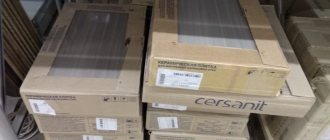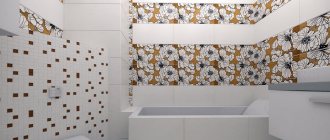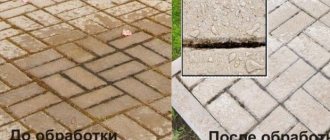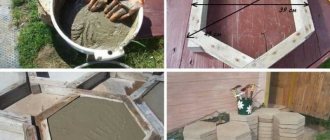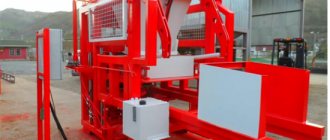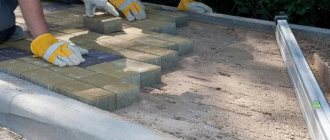You can paint paving slabs in different ways: varnish, water repellent, various types of paint. It should be understood that this is done not only to improve the decorative properties of the surface, but also to protect and extend the service life of the track.
How to paint paving slabs Source static.tildacdn.com
Dye (pigment) for concrete: types of dyes, how to make it yourself
Using pigments, concrete garden paths and borders, paving stones, platforms, building walls and fences, garden furniture, landscape design items (sculptures, flowerpots, etc.) are made brighter and more attractive. Before purchasing dyes, you need to learn about their types and properties, dyeing methods and the effect of the shade of cement on the color of the product.
With the help of dyes, concrete paths become brighter and more attractive.
Benefits of coloring
Paint for paving slabs is often used to improve surface protection from harmful external factors. This method helps to give the material better decorative properties. Among the advantages are the following points:
- The durability of the material is extended;
- A layer of paint makes the base less slippery;
- The coating is wear-resistant;
- Availability of a large assortment of flowers to obtain a beautiful yard design.
Use of ready-made formulations
When deciding how to paint paving slabs, you should pay attention to the following types of materials:
- rubber;
- alkyd;
- polyurethane paints;
- acid mordants.
Rubber paints
The dye for paving slabs is completely harmless , as it is produced without the use of solvents. The finished coating is non-slip, but the disadvantages mentioned above must be taken into account.
The material is water-based and is characterized by the following properties:
- resistance to cracking and wear;
- high elasticity;
- waterproof;
- stability of characteristics in hot and frosty weather conditions.
Alkyd paints
The composition allows you to create a good protective layer, which is due to its resistance to temperature fluctuations, chemicals, and precipitation. Work can be carried out immediately after installation of paving slabs. The coating acquires protection from destruction, provides resistance to mechanical loads and the appearance of salts.
Polyurethane paints
If you buy a polyurethane-based dye for concrete paving slabs, you can count on high strength, wear resistance, and resistance to chemical attack. When working with polyurethane outdoors, it may slightly change shade, but without losing its protective properties. The material is highly viscous and requires the use of personal protective equipment.
Acidic mordants
The active substance, reacting with the concrete surface, forms insoluble compounds. The dye penetrates into the thickness of the tile to a depth of 1.00 mm , which is effective for renewing the surfaces of old sidewalks. The color of the mordant depends on what metal salts are added to the composition during mixing.
We independently create the desired color of the tile at the stage of its manufacture
You can create a dye for paving slabs with your own hands. To do this, you should take the chosen paint and add a certain amount of pigment to it, which, in your opinion, will improve the original color. It happens that the purchased paint does not live up to expectations and requires a slight change in shade. Solving this problem is simple if you know that the pigment chosen for correction will dissolve well in the base composition and will allow you to achieve the intended goal.
Paint for paving slabs, which you create yourself, can be placed in a cement-sand mixture at the stage of its preparation or applied to a ready-made surface. In the first case, you will need to create several copies of the tile, into which different amounts of coloring pigment are placed. Actions of this nature are carried out in order to understand which option will be optimal. The greater the amount of pigment, the brighter your products will look. Some experts suggest that it is more economically feasible to buy unpainted tile material and bring it to the desired condition yourself. For these purposes, it is recommended to choose acrylic paint that has a varied palette of shades.
The procedure for placing paint in concrete mortar
When starting to paint the colorless composition of the future tiles, you should:
- dissolve the pigment in water, the volume of which depends on the saturation of the desired shade;
- carefully pour this solution into the cement-sand mixture;
- Mix the ingredients thoroughly.
You should try to obtain a mass that is uniform in color, since the final result of your work depends on this.
Subsequent stages of making colored tiles
The finished mixture is poured into molds in the prescribed manner and subjected to vibration using a special table. In this way, all components are compacted, obtaining a smooth surface of the product. After drying, the tiles acquire their final color and can be used for their intended purpose.
There are no unique recipes that accurately describe the consumption of pigment required to create paving slabs. The ratios of the ingredients of the coloring composition depend solely on individual wishes.
Making colored tiles with your own hands
When making colored pavers, choose inorganic pigments. They have a large color palette. For a bright and rich color, buy white cement. For duller tones, gray cement is suitable.
Plasticizer is an essential ingredient in the production of paving surfaces. This ingredient allows you to accelerate the hardening of the solution and reduce water absorption of cement.
The pigment is added to the concrete mixer, so you need to prepare it before starting work. The walls of the concrete mixer should be damp, but not wet.
Concrete painting is carried out in the following order:
- The concrete mixer starts working.
- The required amount of water is poured.
- Cement is added.
- The mixture is thoroughly mixed.
- Fillers are added.
- Plasticizer is poured in.
- Color is introduced.
- When the solution acquires a homogeneous mass, it can be poured into molds.
- After a day, the frozen products can be removed from the mold.
Before adding plasticizer to the concrete mixer, it is pre-dissolved in hot water. Forms with concrete should be left in places where there is no draft or high humidity. The room where the workpieces are located must have a stable temperature. Compliance with these conditions will avoid the occurrence of efflorescence. In order to obtain high-quality staining, the following conditions must be met:
- All added ingredients must be mixed well;
- Use cement of the same brand;
- Stir the solution according to the standard time;
- Use additives with caution as they may affect the color of the concrete mixture;
- Use clean, fresh water.
The proportions of pigment can be indicated approximately, so the required amount is determined experimentally.
Before you start painting the paving slabs, you must do some preparatory work.
First you need to very carefully clean the surface of the paving slabs. It is this that determines how well the paint will be subsequently applied.
For example, often the instructions for the paint describe in detail the procedure that needs to be performed - be sure to follow it, and in no case ignore the manufacturer’s recommendations.
Preparation and completion of painting
Dyes for paving slabs require a responsible attitude, so the preparation and completion of painting work are perhaps the most important processes in the whole business.
First of all, you need to thoroughly clean the path - the adhesion strength of the paint to the concrete and the evenness of the painted surface depend on this. It is ideal to wash the walkway with detergent. After this, you need to carefully remove its remains. Also, to remove small particles from the surface and between the tiles, a regular vacuum cleaner or stiff brush is useful. This process is dusty and labor-intensive, so it would be a good idea to carry it out in special clothing.
Finished concrete is painted in several layers. After applying the first, the surface must be thoroughly dried according to the instructions for the dye. When applying the second and subsequent layers, the paint must be mixed and dried between layers.
It will be possible to use the finished coating only after a few days, as it must gain the necessary strength.
Why are paving slabs painted?
Painting paving slabs after laying them is one of the simple and effective ways to change the appearance of your garden plot. It’s quite easy to do the work yourself; the main thing is to comply with all the requirements recommended by the manufacturer. Otherwise, after 2-3 years the surface will lose its original appearance and attractive appearance.
The technology of coloring paving slabs has a number of advantages. The most significant benefits are as follows:
- Fast and high-quality transformation of landscape design.
- The method can be used anywhere, for example, in a garage or a paving yard.
- High-quality protection of paving slabs from the effects of negative natural factors (solar ultraviolet radiation, temperature changes, precipitation).
- Reducing the degree of abrasion, splitting and other mechanical damage.
- Giving the yard surface an anti-slip effect.
- A simple application method that allows you to do the work yourself, without turning to specialists.
Among the disadvantages of the technology for painting paving slabs, we note the following:
- Mandatory roster update. The service life of materials depends on the quality of the work performed and the substance used. Some can withstand up to 10-15 years of use, others no more than 3-4. Therefore, after the surface is painted, it will have to be renewed.
- The moment of application itself has additional inconveniences. This is due to the fact that most coloring compounds have a pungent, poisonous odor. Even if you work in a respirator, gloves and safety glasses, the unpleasant odor will create problems for the rest of the household. Although this problem is temporary and the expected effect may well cover the shortcoming.
- To create a high-quality surface, preliminary preparation will be required. This includes cleaning and priming paving slabs. Carrying out such work will also require time and effort.
Advantages and disadvantages of coloring
Before purchasing the necessary materials and starting work, it is advisable to understand the advantages and disadvantages of this method of updating paths. This, at first glance, simple technology requires the utmost attention from the performer when performing it, because any deviation can lead to the fact that after 2-3 years the paint coating can come off and it will be much more difficult to correct the situation.
The positive qualities of surface paint applied to paving stones are:
- the appearance of the sidewalk or paved area is radically transformed, changing the entire landscape design for the better;
- the layer not only gives the surface a beautiful appearance, but also provides good protection from harmful atmospheric and mechanical influences;
- slipping is reduced in the cold season and after rain in summer;
- special paints, together with pre-treatment, increase the service life of the tile itself.
In addition to its positive qualities, this method also has serious disadvantages:
- the need for periodic repainting of the surface, which can be repeated every 8-12 years;
- the complexity of carrying out work that will take at least several days;
- danger of poisoning from toxic fumes during work.
To avoid poisoning, painting paving slabs is carried out wearing a respiratory mask, periodically taking a break for an hour and a half.
After completion of work
Even after the paint surface becomes dry to the touch, you should not walk on it for several days. The fact is that only the top layer (for example, the third) has finally dried out. But it slows down the final drying of the lower layers. This point must be taken into account when planning work, so that it does not turn out that you cannot enter the house without damaging the fresh paint coating.
Be sure to save one empty paint can or its label. After 5-8 years you will have to tint the tiles, and you can easily choose a material to renew the surface. If you used pigment to change shades, then save information about it.
It is possible to achieve a high-quality and beautiful surface of paths and areas paved with paving slabs, regardless of its shape and past service life. As a result, you can update the overall landscape design of the site and provide good additional protection for the material.
Recommendations before starting work
Since painting of paving slabs in most cases is done outdoors, weather conditions should be taken into account when carrying out the work. Therefore, before painting paving slabs, be sure to look at the weather report for at least the next week.
To carry out the work, dry, windless weather with a temperature above +10°C is required. Application of polyurethane paints is also allowed at subzero temperatures. Therefore, carefully read the instructions for the coloring agent.
The requirement for calm weather occurs because wind will interfere with surface cleaning by sweeping up dust and debris. And if dust and debris fly onto a freshly painted surface, the result will be completely sad.
It is necessary to select several days during which the weather will be close to ideal, and it is not at all so easy to guess. You can organize gradual painting in small areas. Then the work site can be covered with a canopy in case of rain or protected from the wind with a shield. Divide the entire yard into small sectors and carry out work in each of them separately. But, this method, of course, will drag out the whole process for a very long time.
Main characteristics of the dye
Due to the fact that the street surface of paths is exposed to various physical and chemical influences, pigment dye for paving slabs must meet the following requirements:
- • maintain its color under the influence of ultraviolet rays and precipitation;
- • do not dissolve in water;
- • have a high degree of resistance to alkaline environments.
It is recommended to limit the amount of color additives added to the following range:
- • for gray cement 1 - 7% by weight used in the binder solution;
- • for white cement 0.1 – 6% of the amount used in the binder solution.
In this case, they will effectively fulfill their purpose. But when deciding how much dye for paving slabs to add when mixing, you need to take into account that with its excess, you will have to add more water to the solution, since it is not recommended to lay it dry. But it’s also not worth trying to reduce the consumption of dye for paving slabs, since its concentration determines how rich and durable the resulting color will be.
Painting the surface of a concrete path
The painting process can be divided into the following stages:
- After cleaning, dry the surface thoroughly.
- For painting small elements, a brush is useful, and for painting a large surface, you will need a roller with a long handle.
- If you are painting with several colors at the same time, you will need more than one container. Dyes for paving slabs of the desired color are poured into the prepared vessels. This is usually required if the track consists of small elements, and a pre-designed pattern or ornament is applied to it.
- Start painting. This is a responsible process during which caution and attentiveness are required. The paint should be applied in an even layer, without sagging or spots, carefully distributed with a brush or roller. It is imperative to ensure that during painting no particles of dust, dirt, twigs, leaves, etc. get onto the surface. You also need to make sure that bubbles do not form on the painted layer.
Surface painting
Before painting paving slabs using this method, you need to take into account the following nuances:
- in 90% of cases, shaped paving elements are laid on sand or paving stone (a mixture of CPS in the proportion of 1/6 cement, sand, respectively), the seams are filled with the same compounds, which interfere with painting, so they will have to be partially swept out to a depth of 0.5 - 1 cm ;
- it is easiest to paint the tiles immediately before paving;
- after treatment with luminous paints, the tile does not change color and begins to emit a glow only at dusk.
Important! Surface tinting is usually cheaper than buying colored tiles. However, when using phosphorescent and acrylic coatings, the paving budget becomes approximately the same.
Regular paint
Due to the variety of paint and varnish compositions, the problem of how to paint paving slabs during production, after purchasing gray paving stones, or during operation does not arise.
The cheapest option is traditionally to paint with a brush, sponge, roller or spray. The most popular materials:
- epoxy - one or multi-component with the effect of long-term protection against abrasion;
- polyurethane – semi-matte, glossy, two-component composition, resistant to shock, temperature, wind, UV loads, household and industrial chemicals;
- enamels and primer-enamels - organic and polymer compositions with the addition of quartz sand, corundum chips, granotsev;
- rubber – sprayed directly from a can, have an anti-slip effect, reduce structural noise during operation;
- acrylic - minimal finishing budget, low performance properties compared to previous options.
Advice! For areas with heavy traffic, there are water dispersions with the addition of polyurethane and epoxy enamels, wear-resistant curb paints that are not afraid of aggressive environments and have maximum service life.
Luminescent paint
Luminous figured paving elements (FEM) are becoming a competitor to traditional colored tiles. Since the phosphorescent mixture is a paint and varnish material, the technology also involves painting tiles with your own hands.
The main nuances of luminescent paint are:
- the main color is green-yellow, it’s cheap;
- additional shades - turquoise blue, red, are more expensive;
- color effects - the directed beam of a UV flashlight dramatically increases the intensity of the glow.
The technology for applying luminous paint is step-by-step:
- soil – strengthens the base, reduces the consumption of expensive material;
- main layer – 20 g of pigment, 100 g of fine-grained luminous powder, 400 g of varnish or polymer resin;
- varnishing – the surface is protected with a film layer of wear-resistant, quick-drying varnish.
The color of paving stones does not change after treatment with phosphor
Advice! For comfortable lighting (marking) of the path, several FEM elements integrated into the overall pattern are sufficient. Entire parking lots and paths are not covered with luminous paint.
We wrote more about luminous paving slabs here.
Acid etching
The original texture of paving stones during acid etching of concrete is obtained due to the uneven distribution of lime in the composition of the cement stone. Before painting paving slabs with acid paint, simply sweep the sidewalk or parking lot. The technology is suitable for both painted FEM elements and ordinary gray concrete paving stones:
- color choice – blue-green, brown, black, bronze, gold, copper;
- degreasing the front surface of the paving stones - a solvent is used;
- painting - acid paint is applied with a brush, consumption is 0.2 l/m2;
- drying – lasts 3 – 8 hours depending on air humidity;
- neutralization of acid - with a solution of baking soda in water in a ratio of 5 tablespoons per bucket;
- flushing - with pressure from a hose.
Applying acid paint to paving slabs.
After 24 hours of drying, you can additionally coat the paving slabs with a special varnish in one layer.
Important! If the FEM elements are made of ready-mixed concrete, the crushed stone contained in it will not change color from acid paint.
Paving stones after acid etching.
The leading manufacturer of chemical dye is Increte Systems with the Stain-Crete brand in 8 standard colors. The age of the concrete must be more than 2 weeks, the paint layer does not peel off, and prevents the opening of microcracks. Possible effects of aging, imitation of coil, granite, diabase and marble.
Dosing pigments in concrete mixture
The resulting shade of concrete depends on the amount of pigment and color of the cement, mineral admixtures and sand. The amount of pigment that is added to the mixture depends on both the color of the pigment and the required intensity of the resulting color.
Table. Percentage ratio when working with powder and liquid pigment:
| Pigment | Powder | Liquid |
| Red, % | 2 — 3 | 5 — 6 |
| Yellow, % | 6 | 8 |
| Brown, % | 4 — 5 | 6 |
| Black, % | 4 — 5 | 6 |
| Green, % | 5 | 7 |
Liquid pigments must be added to the dry mixture before adding cement and water. It is not recommended to change them in any way by adding other materials or diluting them with water. After adding the required amount of pigment, the mixture is stirred briefly. Then cement and water are added. The preparation of the mixture is completed by stirring.
The following factors can influence the color shade of manufactured paving slabs:
- Amount of pigment. After determining the required amount of pigment using the sampling method, you must strictly adhere to the recipe for the entire batch of tiles.
- Cement color. Gray cement has many shades and never gives the opportunity to obtain a “pure color” of pigment.
- Water:cement ratio. The water-cement ratio is the ratio of the amount of mixing water in concrete and the amount of cement. Mixing water is all the water added to the concrete mixture (water in aggregates, water in liquid pigments, additional water added to the mixture). As the amount of water increases, the color becomes more saturated. When using plasticizers that support cement hydration, it is possible to obtain the desired shade without increasing the amount of mixing water and without compromising the quality of concrete.
- Compacting concrete. Proper compaction allows you to achieve a more saturated color shade, and, conversely, insufficient compaction causes a decrease in its saturation.
- Effect of concrete additives. Additives, most often in liquid form, help to better compact the mixture, reduce its adhesion to the mold, and improve the appearance and physical and mechanical properties of products. The supplement manufacturer's instructions must be followed.
Dyeing technology
To obtain the desired result when painting, you will need to follow some rules:
- To dissolve the powdered pigment, use only clean water.
- Strictly observe proportions.
- The cleanliness of the tools at hand is the key to an excellent result.
If the painting process coincides with the production of paving slabs, then the algorithm of actions changes. Additional steps will be required.
- Preparing a concrete mixer. Before applying the solution, the walls are moistened with water.
- The plasticizer must be diluted in hot water.
- Measure out the required amount of dye, observing the ratio to the cement base. Typically, this is 5% of the total amount of solution.
- Turn on the concrete mixer, and one by one, add all the ingredients: water, cement, filler, plasticizer and coloring pigment.
What can act as a dye for concrete?
Substances that can add color to a concrete structure can be natural or synthetic. For example, using red iron oxide you will achieve a red color in the product, and titanium dioxide will achieve white. Also representatives of mineral coloring additives are red lead, chromium oxide, manganese, etc.
By the way, these additives themselves can be added to concrete, both during the process of mixing it, and after it has hardened directly to the surface. The first option, of course, is preferable, since in this case the color is distributed more evenly and is preserved even despite wear and tear over time.
And the amount of dye added to the solution will tell how saturated the color will turn out. So be careful when choosing a shade and calculating the proportions of the ingredients of the mixture, because the cost of such pigments is quite high, which naturally affects the final price of the finished color product.
Pigments for coloring concrete
There are metal oxide dyes based on:
- iron salts and oxides (yellow, red iron oxide pigments)
- nickel
- chromium (green)
- cobalt
- manganese
- copper and its alloys
- aluminum powder, etc.
Mineral – burnt umber, volkonskoint, ocher. Organic - soot. Synthetic ones are obtained as a result of complex chemical processes.
In Russia, metal oxide materials are produced in Yaroslavl. Czech (Ferpen), Chinese (Yipin Pigments) and others are also common. Danish, Polish, Ukrainian factories are represented on the market.
All dyes that are added to the initial solution during production, regardless of composition, have the following properties:
- They are distributed evenly, without streaks, throughout the entire mass of concrete.
- They do not dissolve in water and other solvents, and are not washed out by sediments.
- Withstand temperature changes without reacting to cold and heat.
- Resistant to prolonged exposure to ultraviolet radiation. The lightfastness of some artificial pigments is slightly lower (for example, phthalocyanine, which provides blue and green colors).
- They are not affected by the alkaline environment of cement mortar; they are resistant to oils, resins, petroleum products and other aggressive substances.
- Available in the form of a fine dusty powder. The smaller the fraction, the higher the quality. Packaging 15-25 kg. For small batches of paving slabs, liquid pigments are used.
Proportions and technological nuances
- They are mixed with water at the rate of at least 3% by weight of the binder (cement). For powders with high coloring power their share is smaller, for pigments with low color intensity – more, up to 8%. The purest tones are obtained when using white cement. The dye consumption for it is reduced to 0.1-6%. However, red, blue, green and yellow practically do not produce whitishness in gray concrete.
- It should be taken into account that the strength indicators of colored tiles are slightly lower than those of unpainted tiles, so for them the mass fraction of cement is increased by 5%.
- The same raw materials are used for the entire batch of painted tiles. The water should not be hard, and the use of plasticizers (0.5% by weight of dry matter) is also mandatory.
Pavement paint
Painting concrete tiles freshens them up and protects them from wear and damage. The procedure must be repeated periodically to extend the life of the coating. It is necessary to paint on dry, warm, windless days. The pavement, thoroughly cleaned with a brush, is washed with a neutral agent, rinsed off and allowed to dry. Then paint is applied, if necessary in two layers. Paint can be:
- Alkyd. Weather resistant, low odor. Abrasion resistance is average.
- Rubber. Creates an elastic surface that does not crack.
- Polyurethane . Viscous and resistant to different weather conditions. May change color slightly after drying.
- Phosphor. Based on phosphorus compounds. As darkness falls, it begins to glow. The total glow period is 6-8 hours. Apply over primer, including light-colored paint, to enhance light reflection. It requires a third, protective layer - varnish.
vote
Article rating
Price
Today, colored concrete products are gaining popularity, so buying a dye for paving slabs, the price of which depends on its type, is not difficult.
You need to know that liquid dyes are about three times cheaper than dry powder pigments.
The cost of the dye depends on its type, color and manufacturer: acrylic paints can be purchased at a price of 50 to 80 rubles per kilogram, and inorganic pigment powder costs from 7 to 15 rubles per kilo.
In addition to pigments, to make a garden path you need to buy a plastic mold that will make the path attractive and unusual. If there is no special mold, you can make ordinary bricks.
Pigments are fine powdery substances that do not dissolve in water, drying oils, resins and other film-forming suspensions. Dye for paving slabs is obtained by grinding natural or artificial materials. Sulfides, oxides and salts of iron, cobalt, chromium, powders of aluminum, nickel, zinc, copper and its alloys, and soot are used as initial dyes. Various technologies for using dyes make it possible to change the appearance of the tiles, giving them an exclusive decorative effect, achieving almost any color or shade.
There are two approaches to obtain colored paving slabs. In the first case, pigment is added to concrete during its mixing process, and through-coloring occurs. In the second, the dye is applied to the surface of the finished tile, which leads to a change in color of only its thin layer. An example is dispersion paint for concrete sidewalks. This approach is cheaper, but with mechanical wear of the surface, the shade will change until it disappears completely.
Pigments for coloring concrete in general and for paving slabs in particular are classified as follows:
- metal – powders obtained from iron salts, non-ferrous metals and their alloys;
- natural - inorganic dyes produced from rocks and minerals by enrichment, heat treatment and grinding;
- synthetic - complex chemical compounds formed as a result of chemical reactions, as well as obtained through high-precision technological processes.
The basis for tile production is concrete, therefore the coloring substances used in this production have:
- resistance to the alkaline environment created by cement;
- stable and uniform distribution in the concrete mass;
- independence from various weather conditions (precipitation, temperature changes);
- preservation of properties from ultraviolet rays.
During the manufacturing process of concrete, pigments do not dissolve in water, but form an emulsion with it, which promotes uniform distribution, and interact with cement. Therefore, when drawing up proportions, you should focus not on the total mass of concrete, but on the amount of binder.
Depending on the type of pigment and brand of cement (which can have different shades of gray or white - more sensitive to coloring), the ratio will be 3÷5% by weight of the binder.
A special pigment for painting paving slabs is characterized by the following properties:
- hiding power - the ability to paint the surface or the entire material as a whole in the color of the dye, completely changing the original shade of the product;
- light fastness – color retention under long-term ultraviolet rays;
- intensity - the ability of a dye to transmit its color when mixed with a white pigment;
- dispersion - microscopicity of fractions, affecting all other (with the exception of alkali resistance) properties;
- alkali resistance – the ability not to change color in an alkaline environment.
